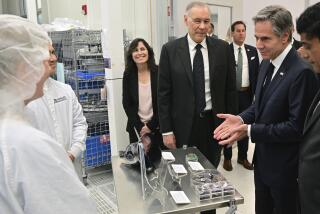U.S. Firms Planning Joint Venture in Computer Chips
- Share via
PALO ALTO — A group of leading U.S. electronics companies, in an unprecedented move intended to blunt Japanese competition, is expected to announce today that it hopes to commit hundreds of millions of dollars over the next few years to form a consortium and operate a plant to produce key computer-memory chips.
Led by International Business Machines, the group of computer and semiconductor manufacturers has concluded that a large domestic supply of so-called dynamic random access memory chips (DRAMs) is essential to retaining U.S. competitiveness in several key industries. By forming a joint corporation, tentatively called U.S. Memories Inc., these companies would have an alternative to Japanese sources of DRAMs.
The expected announcement today in nearby Santa Clara by an industry trade group is a first step toward forming such a consortium. About a half-dozen companies reportedly are interested in the deal and are willing to fund a detailed plan for the consortium’s operations, sources said. Forming the venture would hinge largely on regulatory approval.
Although several of these firms have participated in various joint research projects, this would be the first such large-scale manufacturing venture in this or any other industry. Its approval would also mark a major change in antitrust policy.
In addition to IBM, the firms willing to make an initial commitment include semiconductor makers Intel Corp. and National Semiconductor Corp. and computer company Hewlett-Packard Co.
IBM, in a departure from its traditional policies, is considering contributing DRAM designs to the venture. The company’s memory technology, currently used in the production of chips for IBM computers exclusively, is considered to be among the best in the world.
It is expected to take several months for the firms in the consortium to decide whether to actually commit millions of dollars to form the corporation and begin manufacturing the DRAMs.
The firms are not expected to seek government funding, at least initially, but the venture almost certainly will need exemptions from antitrust restrictions, since its participants are competitors and customers of one another.
“Any consortium that brings together U.S. electronics companies to further our global advantage is a step in the right direction,” said William Krause, chairman of the American Electronics Assn. “I find this to be a very positive step,” added Krause, who was familiar with the consortium plans.
DRAMs, pronounced “DEE-rams,” are essential computer components that store information.
U.S. firms invented the DRAM, but one-by-one U.S. manufacturers left the market in the early 1980s in the face of softening demand and intense Japanese competition. Three U.S. firms now hold only a small share of the $6-billion worldwide market.
DRAMs are known as technology “drivers” because they are produced in high volumes and the skills learned in making them can be applied to other semiconductor products.
In the past few years, the DRAM has become the focal point of trade tensions between the United States and Japan as the federal government investigated charges that Japanese producers were dumping, or selling the chips below cost, in the U.S. market.
In 1986, when the United States and Japan signed an unusual trade pact that set minimum sales prices for certain imported Japanese DRAMs, government officials expected that U.S. firms would use the window to reenter the market. But only one major U.S. firm--Motorola Inc.--has done so.
For the past year, several U.S. firms have explored the possibility of making the chips but were scared away by prohibitive costs and the fear that efficient Japanese producers would continue to dominate the market.
In an interview earlier this year, Intel Corp. Chairman Gordon Moore said he estimated that setting up a DRAM line would cost $200 million to $300 million. “And that’s only the down payment. You have to maintain your technology from generation to generation,” he said.






